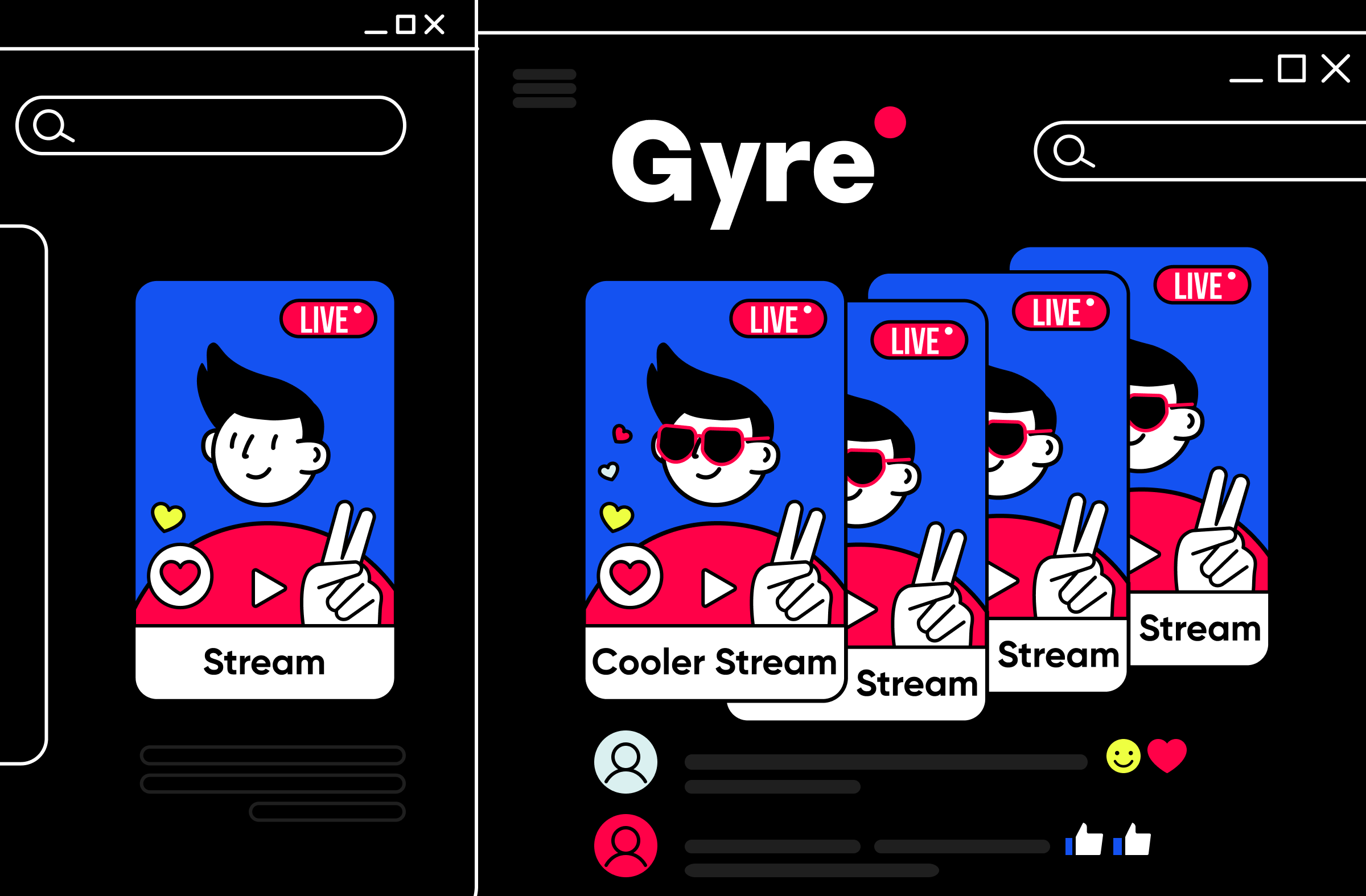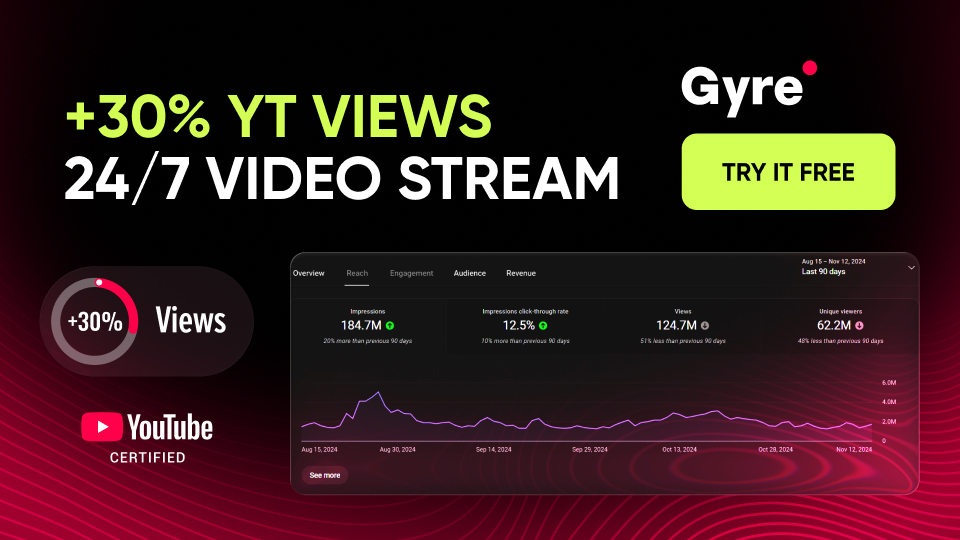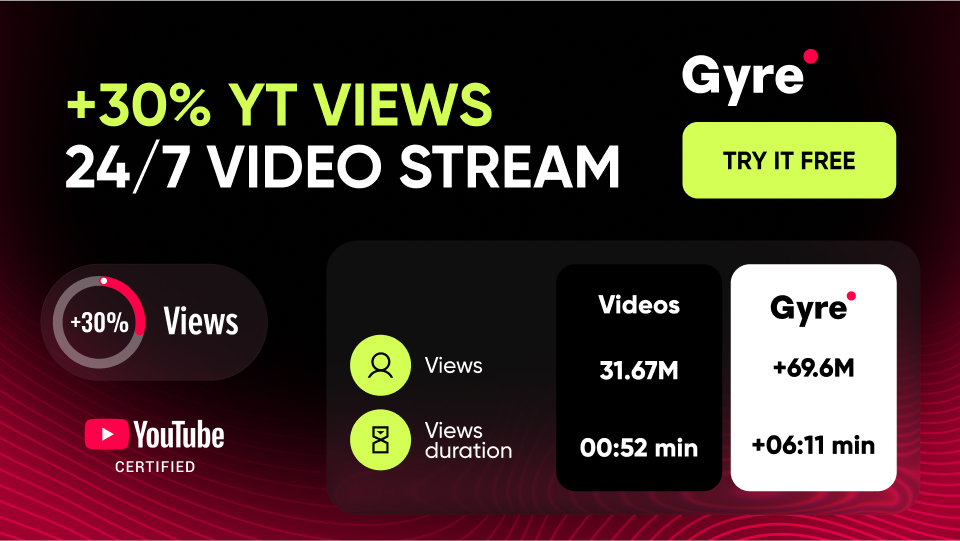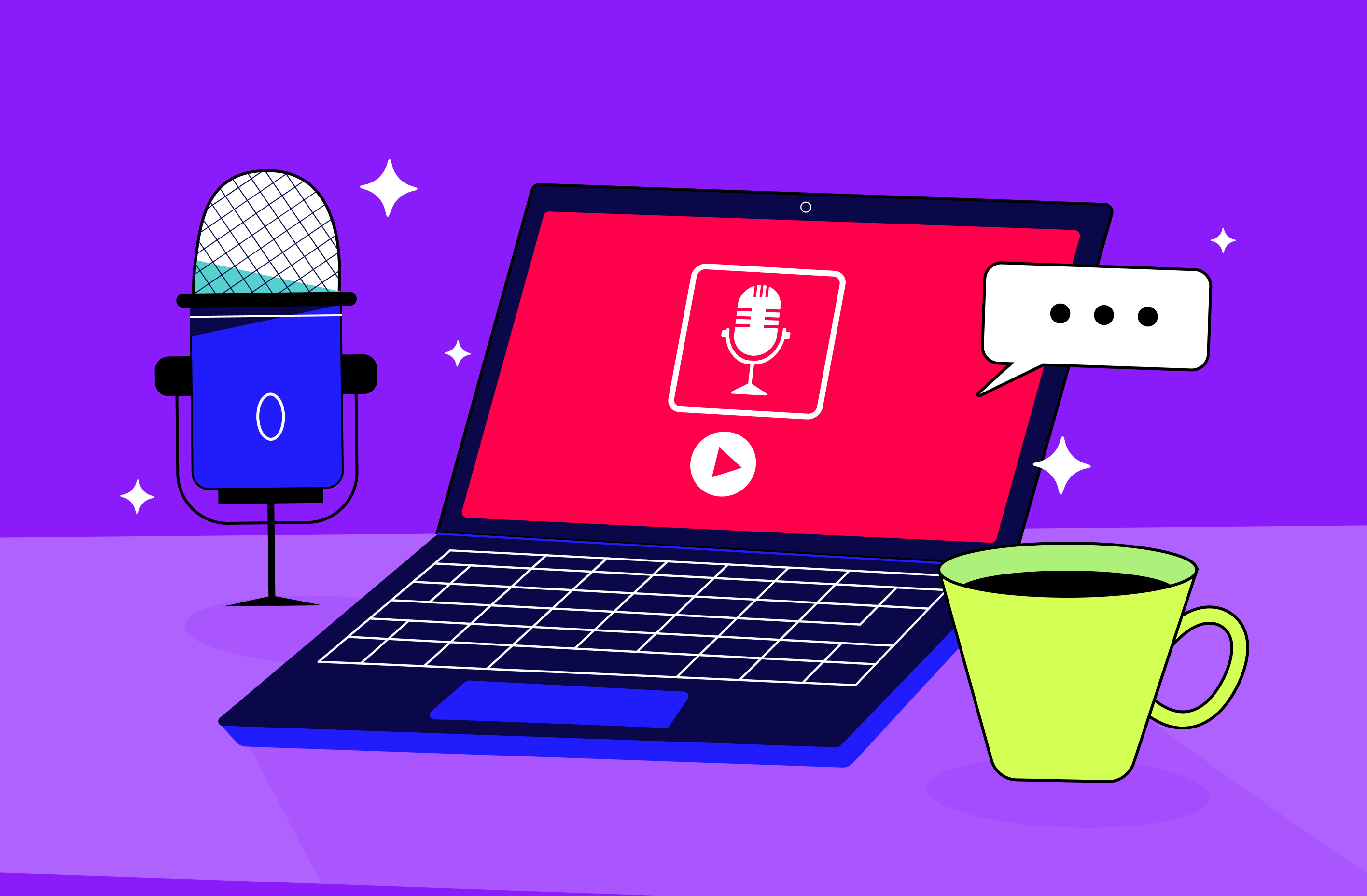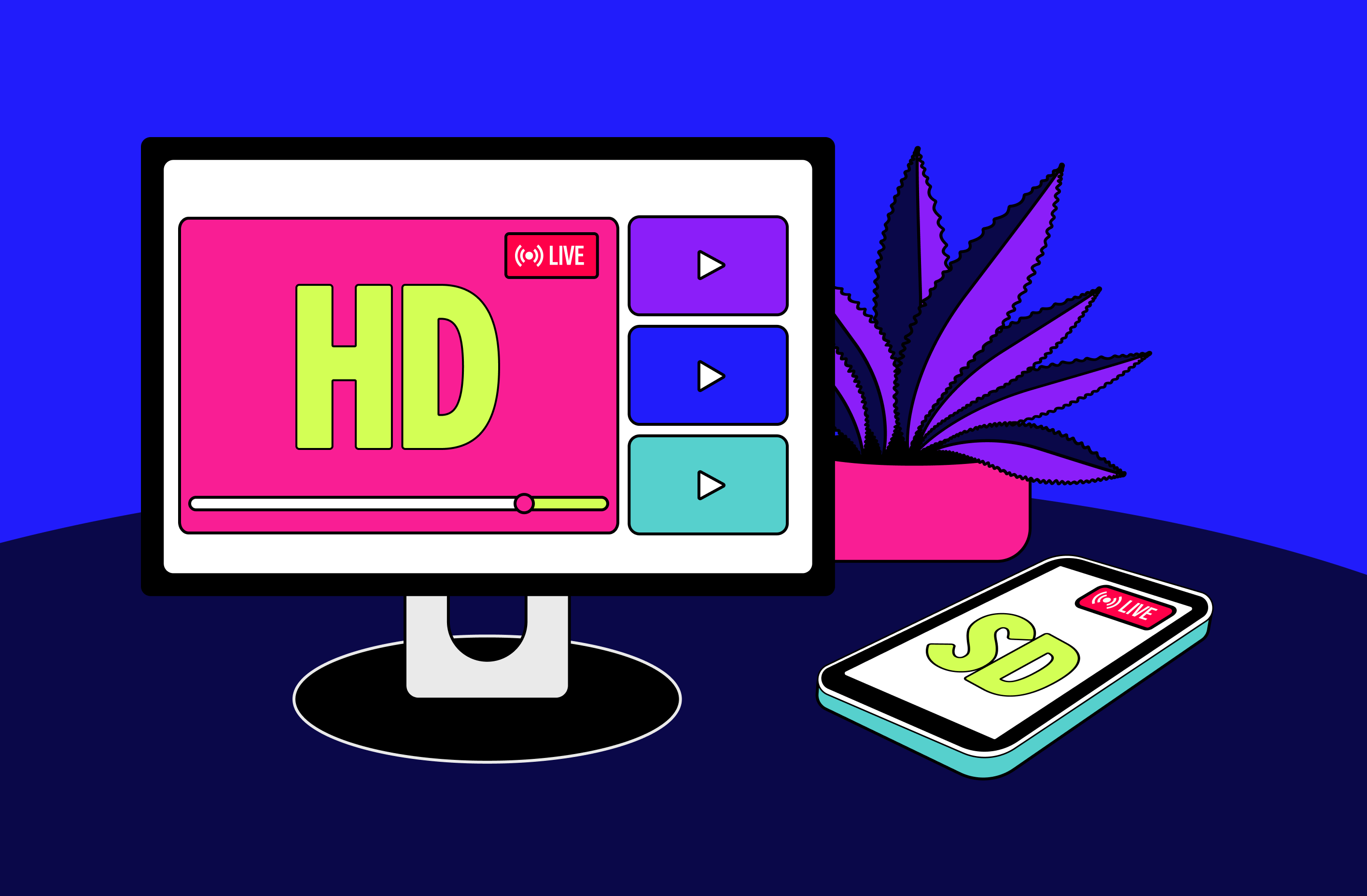Back in 2019, streams were a trend gradually picked up by some YouTube channel owners. In 2025, live streams are a must-have, a mandatory element of channel development to get into trends.
But why are viewers drawn to live streams?
- It’s information in the simplest presentable form.
- Actual data. So, for example, news channels stream almost continuously, covering cultural, social, and political spheres comprehensively and topically for specific moments.
- Communication at two levels: 1) between the viewer and the author of the stream; 2) a network between stream participants. Most often, people come to streams for communication and acquaintances. Each stream is a concentration of people with a certain interest.
Of course, not all channels are suited for the classic format of streams with a live presenter, but this does not mean there’s no other way to stream content live. This is where continuous streams come to the rescue.
What is continuous streaming?
Continuous streaming is a stream created from ready-made clips played on repeat 24/7, creating an endless continuous video stream.
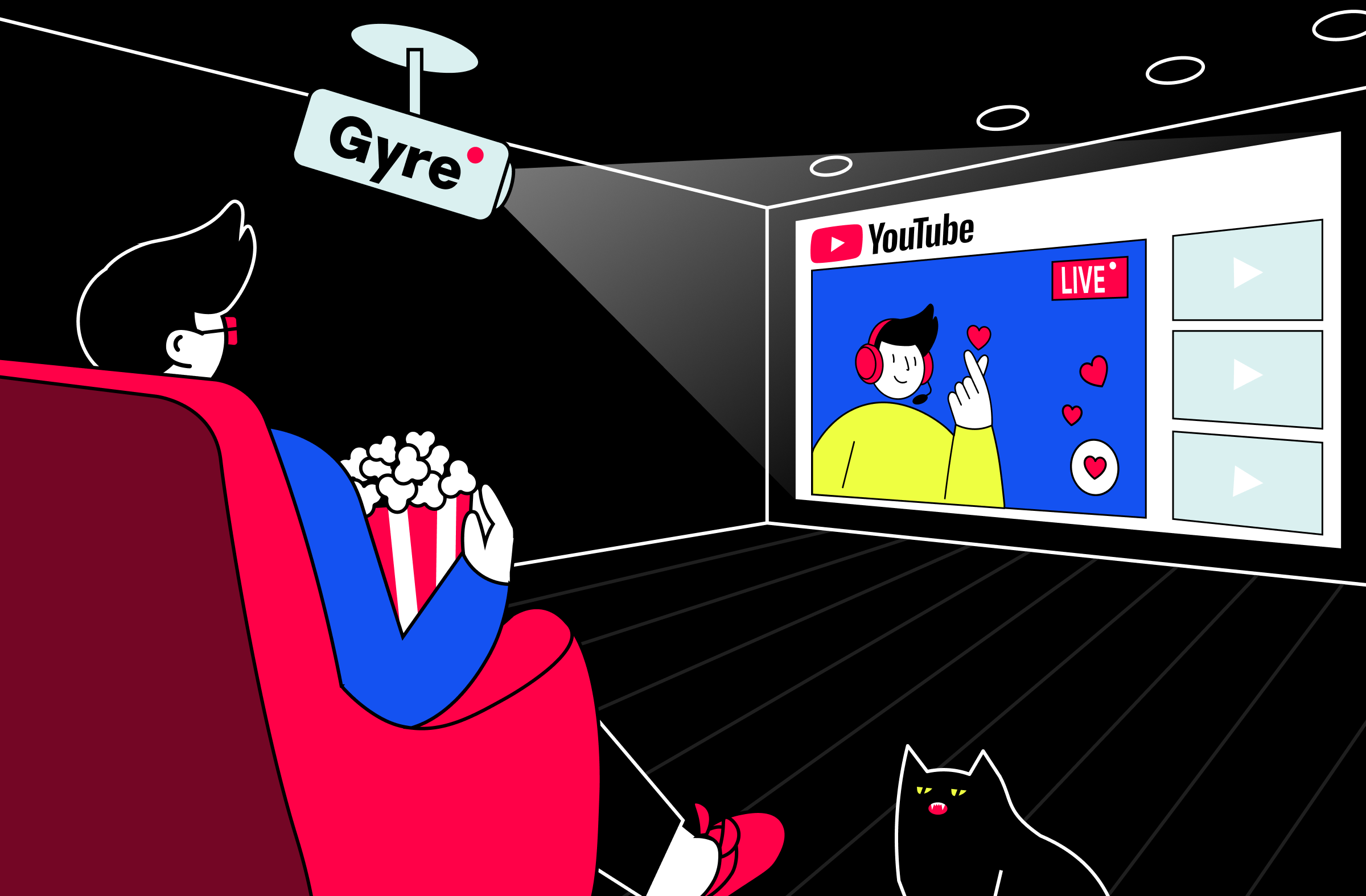
In other words, you choose one or more video files to stream, play for viewers in live mode, and restart it again when the video ends.
Actually, a continuous streaming is the same as a live broadcast on YouTube, only unlimited in duration using pre-recorded videos.
Separately, in the article, we describe how continuous streams differ from a traditional live stream and how continuous streams affect the development of a YouTube channel.
One of the advantages for channel owners is that YouTube algorithms invite new audiences to join the live stream; that is, new viewers not previously subscribed to the channel but who could potentially be interested in your content. Therefore, launching streams is a great opportunity to gain new subscribers.
We have yet to mention the fact that when new viewers watch your stream for the first time, they’re shown advertisements that can be monetized. And most viewers check out the main channel content after watching the stream.
Those are solid pluses from streams!
Can streams be monetized?
In short, the answer is: "Yes, of course."
Here’s the detailed answer.
Each video on your channel performs a certain function (ideally several). One video may have extremely high viewer retention, another may have a lot of views, and a third may be interesting to advertisers and have the highest CPM on the channel. Ultimately, your videos bring new traffic, subscribers, monetization, sales (for the appropriate channel topic), form an image and brand, social activity (likes/reposts/comments), and more.
Likewise, continuous streams will benefit your channel by boosting continued channel activity, generating new traffic, increasing audience reach, increasing average watch time, and monetizing views and watch time.
Since continuous streams on the YouTube channel look similar to live streams, monetization of continuous streams is subject to the same rules as classic live streams.
If channel monetization is enabled and you remembered to enable monetization when starting the stream, all stream views will be converted into income.
In addition, continuous streams can also be monetized through sponsorships or by enabling ads and using Super Chat.
This year, YouTube updated its policies and monetization methods for streams, proving once again that streams are a priority for the video platform. When creating a stream, the creator can activate the automatic placement of ads within the stream. YouTube, in turn, automatically adjusts when the advertisement is shown. We remind you that earlier, there was advertising on live streams only for newly joined viewers to the channel.
So, let's summarize. From now on, when you start a stream, you have three ways to monetize:
- Display advertisements before the start of the stream.
- Income through a Super Chat connection.
- And additionally, with an update — display advertisements within the stream (until now, this was only available for videos).
To activate the ads display within the stream, you must check the corresponding check box in the YouTube Creative Studio while creating it.
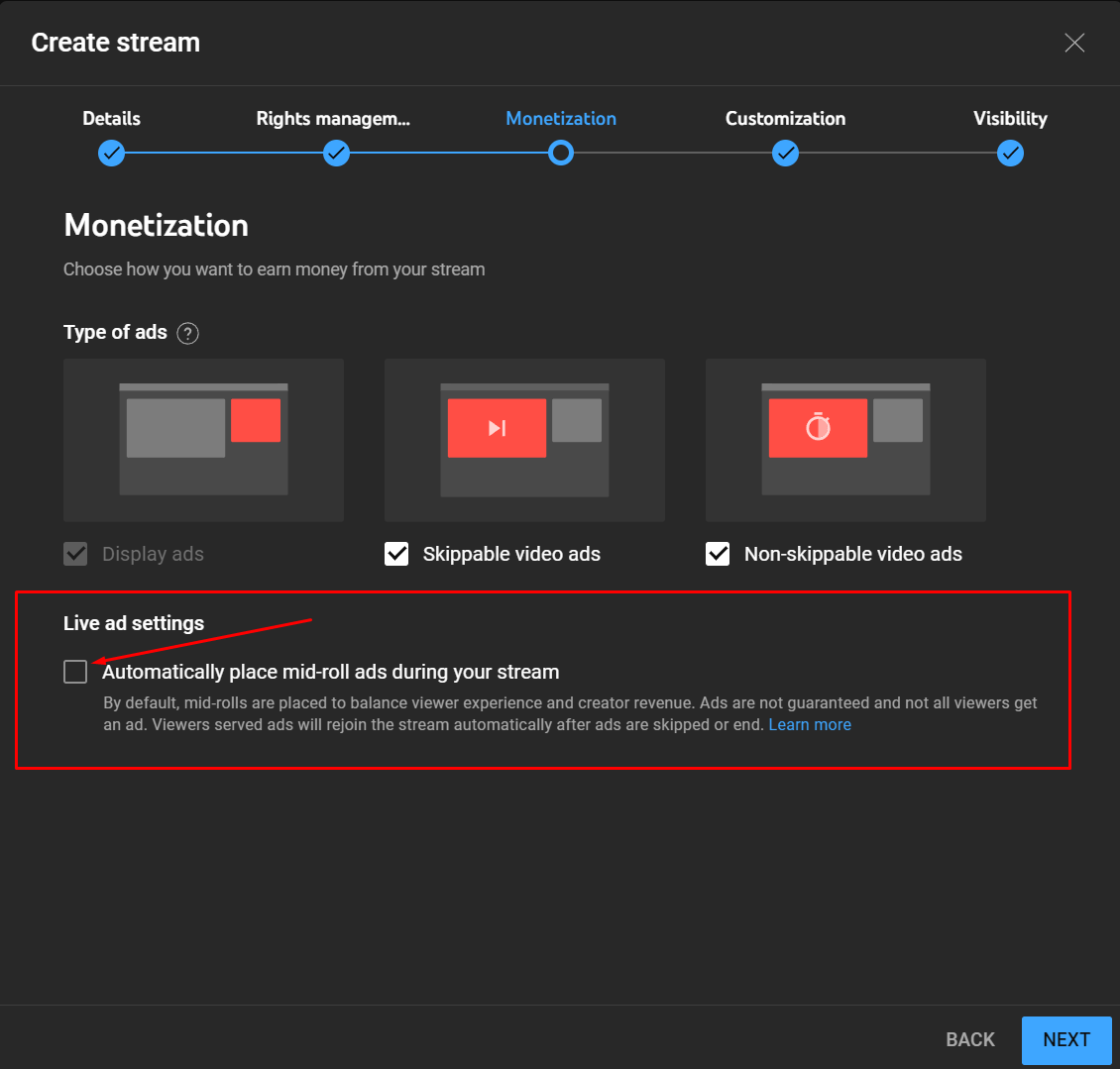
6 Indicators that are Affected by Continuous Streams
The launch of even one continuous stream affects the growth of the following indicators:
Total views
Watch time
Viewer retention
Subscribers
CPM
Channel revenue
But that's not all. Can you believe it? Here are more reasons why we love continuous streams so much:
- Continuous streams give your content a new lease on life, allowing you to earn additional revenue by streaming it live.
- With 24/7 streaming, it’s easier to get YouTube to recommend your videos. On average, by channel, classic videos are recommended 72% of the time and 96% for streams.
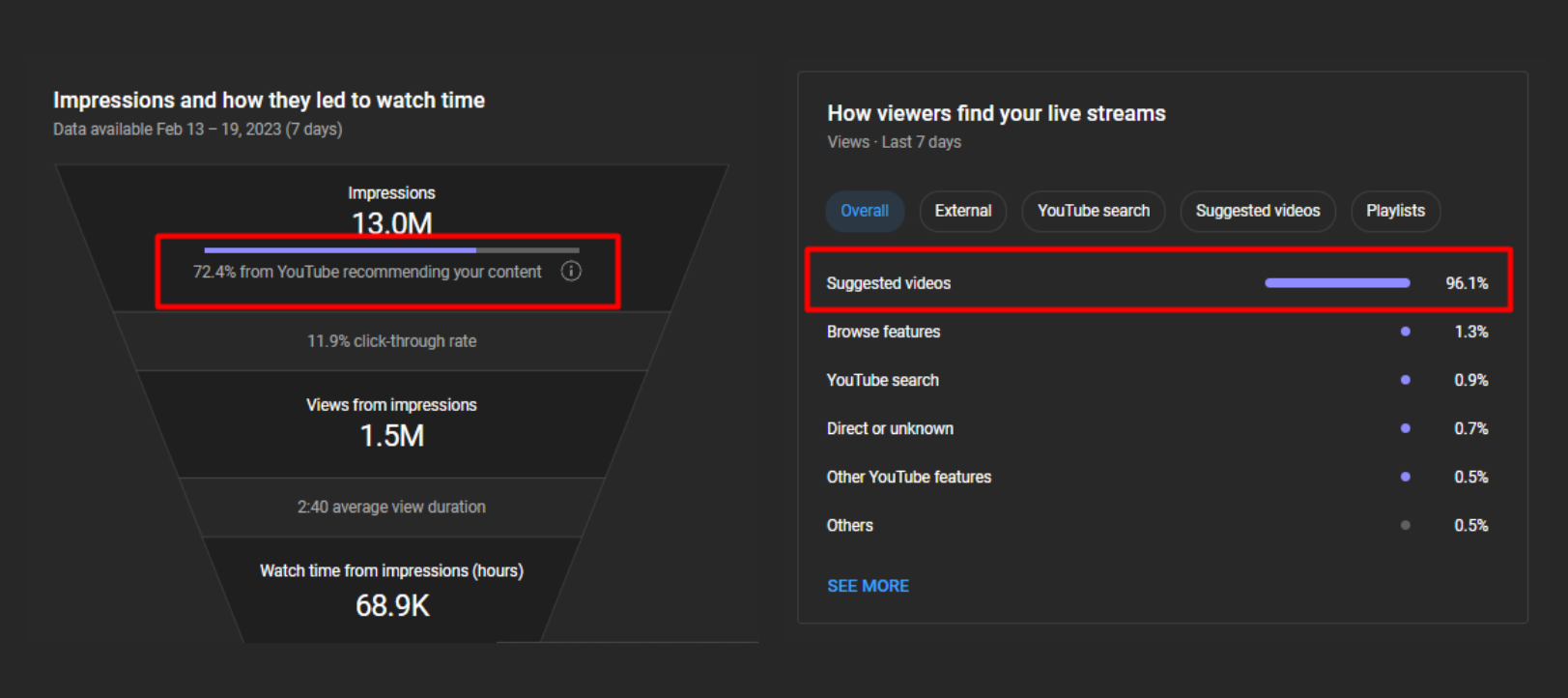
- Traffic from a continuous stream can be transferred to new videos to give new content maximum thrust in the first minutes after publication.
- For YouTube, a stream is just as valuable as a video, so by starting a stream, you maintain regular posting. In this way, streams become that safety cushion and keep the channel afloat when you can't publish new content.
- Gyre streams are like low-maintenance flower pots. Since the stream comes from cloud storage, there’s no need to constantly worry about an Internet connection or keeping your computer on. In general, a continuous stream can be started even from a phone.
- If you can physically conduct only one live stream (albeit with additional software on several platforms at the same time), then you can run up to 8 continuous streams on your YouTube channel simultaneously and multiply the received views, subscribers, and profit by 8.
The results of continuous streams on the YouTube channel
The best way to demonstrate the success of continuous streams is by using a real success story. So below, you’ll see the results of 24/7 streams on the Power Vision channel for one month in 2022.
General channel info: 1.3k entertaining videos were published on the Power Vision channel, and 9.66 million YouTube users subscribed.
For November last year, this Gyre user received a total of more than 10 million views out of a total of 15.9 million views on the channel. The average time a viewer stays on a continuous stream per month is 13:26 min, 9 minutes more than a regular video. The watch time indicator is 86%, which means viewers watched over 2 billion hours of continuous streams.
Just imagine: 87% of the channel's total revenue occurred the month they started continuous streams. During this period, as a result of streams, the channel received more than 28,000 new subscribers.
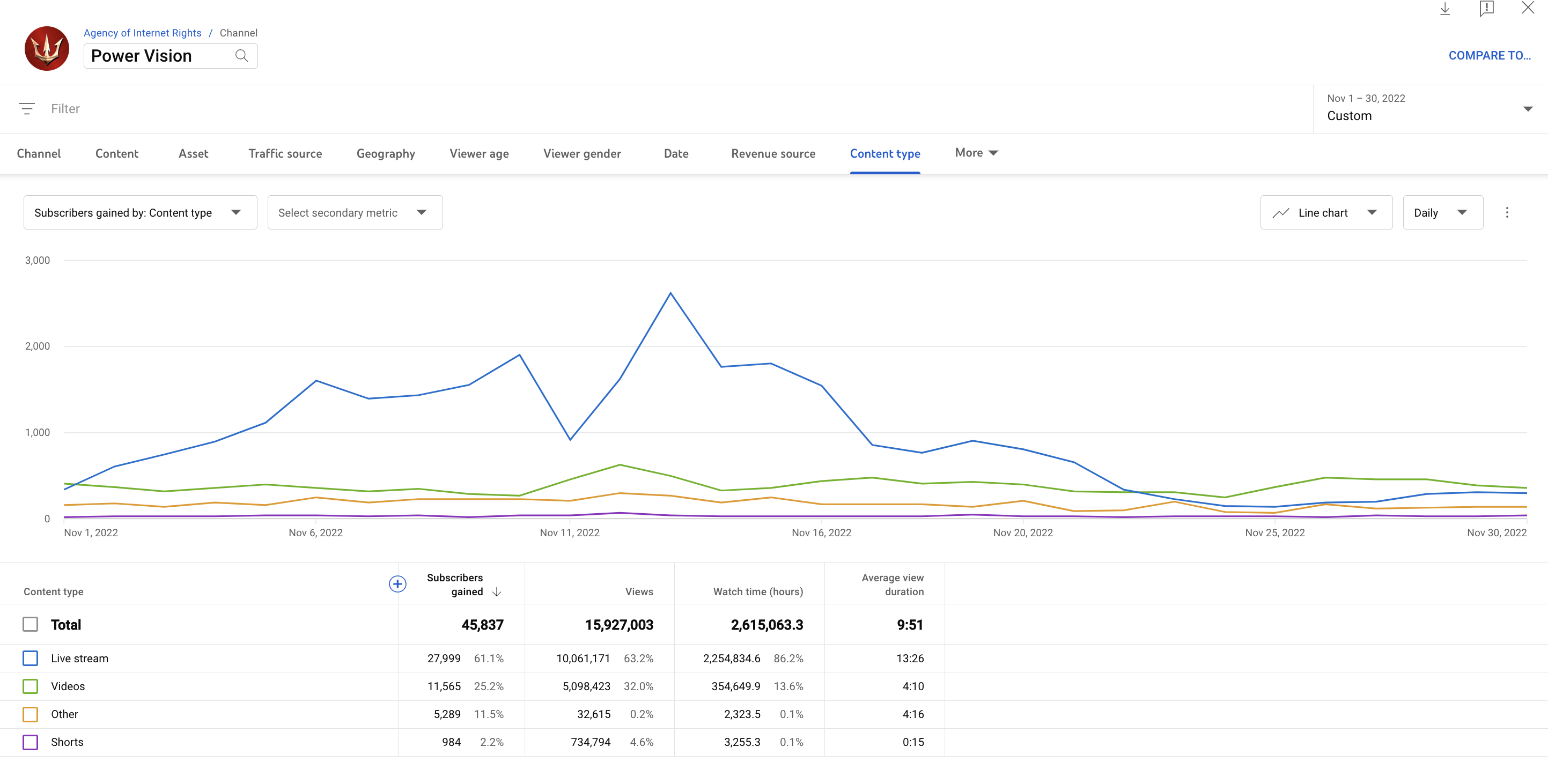
This result can be expected, depending on the month, and there are fluctuations in the indicators. But in general, for 2022, the steady launch of 1–2 simultaneous continuous streams resulted in more than 132,000 new subscribers for that channel.
The channel earned an additional 43% profit from broadcasting existing content using continuous live streams.
The channel received more than 75 million views, accounting for 1/5 of all channel views.
Viewers spent 11.5 billion hours watching streams, almost half the total retention rate.
The average viewer retention time on streams was 9 min, compared to 4 minutes for regular videos.
If you’re interested in learning more about the results of continuous streams from other success stories, we encourage you to read the article about how to get 128k followers in 152 days with Gyre streams.
Start-up Cost and Payback Period for Gyre continuous streaming Packages
This section will be practical and filled with statistics and math. Get your calculator ready if you’re interested in assessing your own channel.
On average, every Gyre user runs 21 streams per month and restarts it every 3 days. This time is enough for the stream to reach peak results. Restarting the stream every 3 days is a basic strategy (and not the only one) suitable for calculations because many users do this.
You need to select a specific strategy for each channel based on its characteristics. Restarting the stream once every 3 days is not a must but a recommendation.
The most common package is Start+ ($99 per month), which allows you to launch a YouTube channel/s simultaneously for up to 4 continuous streams.
Here’s what we have: under ideal conditions and considering that the stream restarts once every 3 days, the Start+ package allows users to launch 40 streams per month. We get that number by dividing 31 days by 3 (the number of restarts) and multiplying by 4 (the number of streams in the Start+ package).
The cost is about $2.50 per stream launch.
$99 (monthly cost of the Start+ package) / 40 streams.
Even if the user sometimes forgets to restart and has 30 streams per month, one continuous live stream will still cost about $3.50.
What is $3.50 in the context of YouTube channel development? Well, frankly, nothing.
No paid promotion for this amount would bring organic traffic, new subscribers, viewer retention, and viewing time to the channel.
Any advertising will cost much more. By the way, in this article, we calculate the cost of an additional 100,000 by comparing the cost of Google Ads advertising to the launch of Gyre streams.
How much can you earn from continuous streams?
How can we do it without success stories?
This time we’ll look at the Pikameo Gameplay channel in the gaming vertical. 536 videos have been published on the channel, and 242,000 people have subscribed to the creator's content. 4 continuous streams are active on the channel.
In August 2022, the channel launched 222 streams. These are both new and restarts of continuous live streams. In total, continuous streams brought the channel almost $2,000.
But we have a surprise for you. We have statistics of stream income for every day. Yes, yes, for each day!
In 1 day of work, a total of 4 continuous streams steadily increased channel income from $44 to $88.
And there’s more. A month after launching 24/7 streams on the channel, almost 6,000 YouTube users subscribed. On average, the viewer stayed on the stream for 3:38 min, while a regular video averaged 2:02 min.
These results will surely inspire you not to miss out:
The channel received 4.5 million views (71% of all views) using streams.
Viewers spent 278,000 hours viewing streams, 80% of the total watch time.
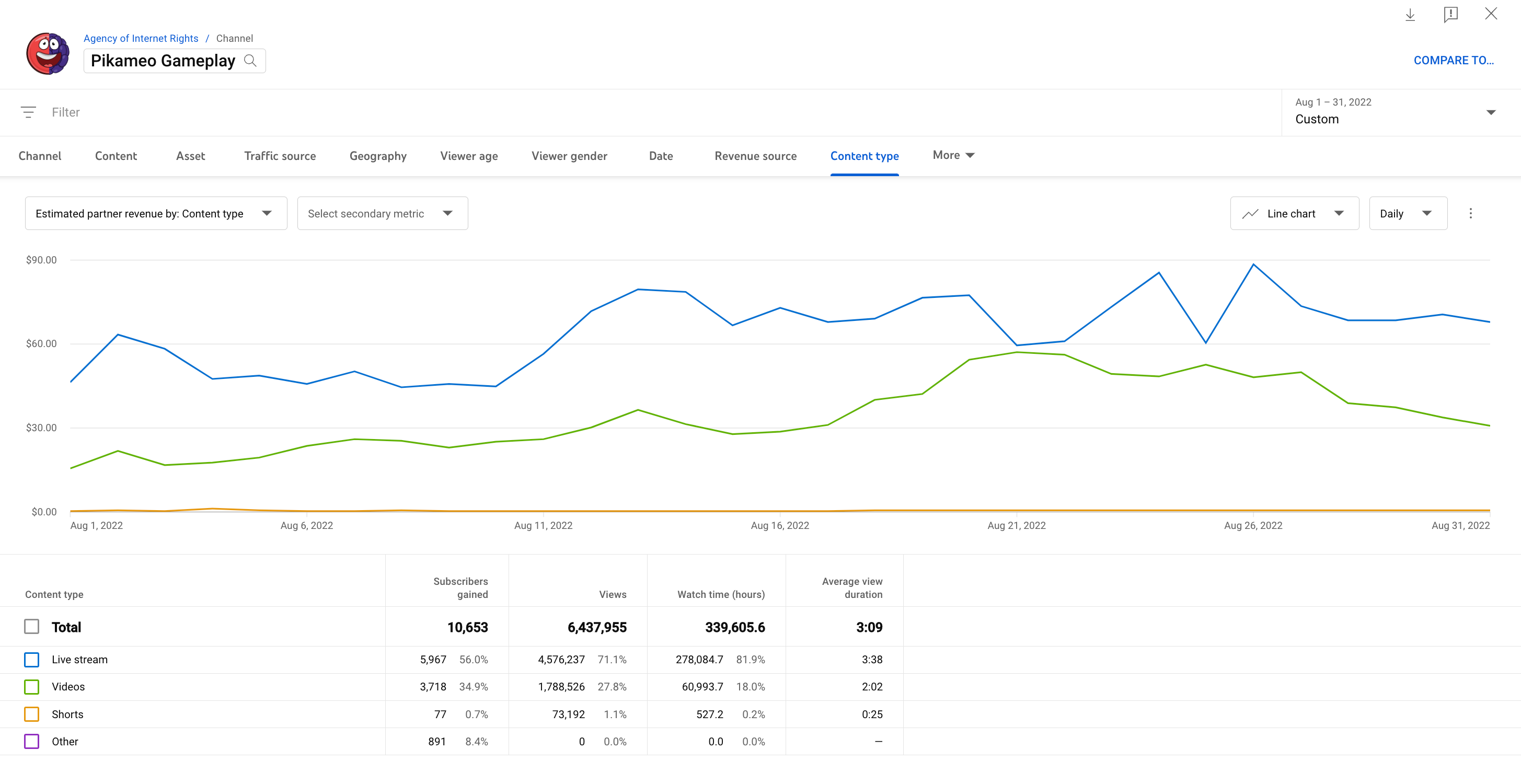
We know! These results are amazing. Especially considering that by starting and restarting streams, you can recover the costs of the package in 1-2 days and then monetize your content and receive additional income.
There is one point we’d like to emphasize. You can use various promotional and advertising methods to develop your YouTube channel.
You can combine streams with a paid Google Ads promotion giving your channel an even stronger boost. But in principle, streaming is a self-sufficient method of promotion. You have probably already encountered minor or sharp drops in dynamics after suspending advertising traffic in channel analytics. Organic channel traffic may decrease and can only be returned by repeating a paid promotion. It’s especially unfortunate if you launched advertising but the money spent did not pay for itself, and your content did not make it into the recommended list.
We assure you that once you stop launching continuous streams on your channel, the dynamics of activity will remain the same because live streams are directly supported on your channel. Everything is simpler than it seems; continuous streams are pure organic traffic because the algorithms promote streams better. In addition, such a method of promotion is much cheaper than a paid promotion.
You can test the effectiveness of streams on your YouTube channel by launching live streams with a free 7-day trial package.


